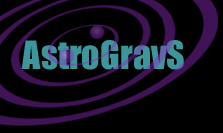This website is kept for archival purposes only and is no longer updated. Skip to content
 Mock LISA Data Challenge
Mock LISA Data Challenge
LISA Data Analysis
LISA is a constellation of three spacecraft that uses laser interferometry to precisely measure distance changes between widely separated freely falling test masses housed in each spacecraft. The spacecrafts are at the corners of an equilateral triangle 5x10^6 km on a side in heliocentric orbit. LISA should observe low frequency gravitational radiation from likely sources out to cosmological distances, and would be an important complement to the ground-based experiments already being operated. LISA is a NASA/ESA mission and is expected to launch at the beginning of the next decade.LISA will be able to detect gravitational waves from several types of sources. Our knowledge of these sources and the gravitational waves they are expected to emit will guide the analysis of the raw mesurement data which LISA. Similarly, our mock data challenge problems are organized by gravitational wave source types, including the following source classes:
- Galactic binaries
made up of neutron stars, white dwarfs, ordinary stars, or black holes in our Galaxy. LISA will be sensitive to so many of these systems that they will not all be distinguishable in the data, providing a great deal of information about these systems, and a special data analysis challenge.
- Massive black hole (MBH) mergers
occuring where distant galaxies have interacted. These massive black holes are thought to exist in the centers of most galaxies. LISA will be sufficiently
sensitive to these systems that they will be detectable to very large distance
(up to redshifts z>10). Some may be detected with signal-to-noise ratio
SNR>10000.
- Extreme mass ratio inspirals (EMRIs) in which a star-sized compact object falls into a massive black hole at the center of a distant galaxy. Careful study of these systems through LISA observations will allow us to measure the properties of spacetime around the MBH, providing a strong test of Einstein's theory of gravity.